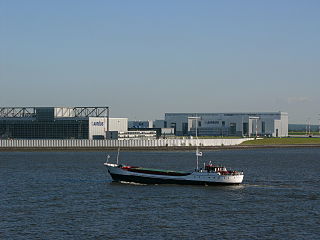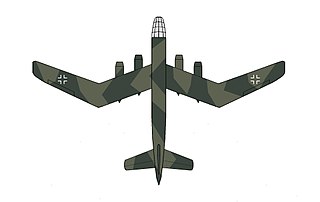
Blohm+Voss (B+V), also written historically as Blohm & Voss, Blohm und Voß etc., is a German shipbuilding and engineering company. Founded in Hamburg in 1877 to specialise in steel-hulled ships, its most famous product is the World War II battleship Bismarck. In the 1930s its owners established the Hamburger Flugzeugbau aircraft manufacturer which, shortly before the outbreak of World War II, adopted the name of its parent company. Following a difficult period after the war, B+V was revived, changing ownership among several owners, as Thyssen Group and Star Capital. In 2016 it became a subsidiary of Lürssen and continues to supply both the military and civil markets. It serves two areas: new construction of warship as NVL BV & Co. KG and new construction and refit of mega yachts. The company has been in operation, building ships and other large machinery, almost continuously for 145 years.
Hamburger Flugzeugbau (HFB) was an aircraft manufacturer, located primarily in the Finkenwerder quarter of Hamburg, Germany. Established in 1933 as an offshoot of Blohm & Voss shipbuilders, it later became an operating division within its parent company and was known as Abteilung Flugzeugbau der Schiffswerft Blohm & Voss from 1937 until it ceased operation at the end of World War II. In the postwar period it was revived as an independent company under its original name and subsequently joined several consortia before being merged to form Messerschmitt-Bölkow-Blohm (MBB). It participates in the present day Airbus and European aerospace programs.

The Henschel Hs 293 was a World War II German radio controlled glide bomb with a rocket engine slung underneath it that boosted the bomb in front of the launching bomber in order to make it more visible to the bomb aimer. It is the first operational anti-shipping missile, first used unsuccessfully on 25 August 1943 and then with increasing success over the next year, ultimately damaging or sinking at least 25 ships. Allied efforts to jam the radio control link were increasingly successful despite German efforts to counter them. The weapon remained in use through 1944 when it was also used as an air-to-ground weapon to attack bridges to prevent the Allied breakout after D-Day, but proved almost useless in this role.

The Emergency Fighter Program was the program that resulted from a decision taken on July 3, 1944 by the Luftwaffe regarding the German aircraft manufacturing companies during the last year of the Third Reich.

Wunderwaffe is German for "Wonder Weapon" and was a term assigned during World War II by Nazi Germany's propaganda ministry to some revolutionary "superweapons". Most of these weapons however remained prototypes, which either never reached the combat theater, or if they did, were too late or in too insignificant numbers to have a military effect.

The Blohm & Voss BV 246 Hagelkorn was a guided glide bomb developed to bomb specific targets once it was released.

Airbus Hamburg-Finkenwerder, also known as Hamburg Finkenwerder Airport, is an aircraft manufacturing plant and associated private airport in the Finkenwerder quarter of southwest Hamburg, Germany. The airport is an integral part of the Airbus owned plant, and is exclusively used by them for corporate, freight, test and delivery flights, including the former Airbus A380.

Wenzendorf is a municipality in Lower Saxony, Germany. It is also the name of the chief village of the municipality.
Richard Vogt was a military German aircraft designer who was known for his original airframes, including the asymmetrical BV 141 during World War II. After the war, he moved to the United States as part of Operation Paperclip, where he worked on American military aircraft design.
Hermann Pohlmann was a German aerospace engineer.

The Blohm & Voss P 170 was a three-engined unarmed fast bomber and ground-attack aircraft project proposed by the aircraft manufacturer Blohm & Voss to the Luftwaffe during the Second World War.

The Blohm & Voss Bv P 188 was a long-range, heavy jet bomber design project by the Blohm & Voss aircraft manufacturing division during the last years of the Third Reich. It featured a novel W-wing planform with variable incidence.
The Blohm & Voss P215 was an advanced jet night fighter project by Blohm & Voss during the Second World War. With a crew of three and twin jet engines, it featured a tailless swept-wing layout and heavy armament. An order for three prototypes was received just weeks before the war ended.
The Blohm & Voss BV 950 was an anti-shipping air-launched glide torpedo developed in two variants, the L 10 Friedensengel and L 11 Schneewittchen.
The Blohm & Voss P 163 was a design project for an unconventional bomber during World War II. Constructed mainly from steel, its crew were accommodated in large wingtip nacelles, giving it a triple-fuselage appearance. Its propeller drive system was also unusual, with the central fuselage containing twin engines coupled to a front-mounted contra-prop.
The Blohm & Voss P 200 was a design project for a transatlantic transport flying boat during World War II. It was intended to go into production for Deutsche Lufthansa after the war.
The Blohm & Voss P 202 was an unusual design study for a variable-geometry jet fighter during World War II. It was the first design to incorporate a slewed wing in which one side swept forward and the other back.









